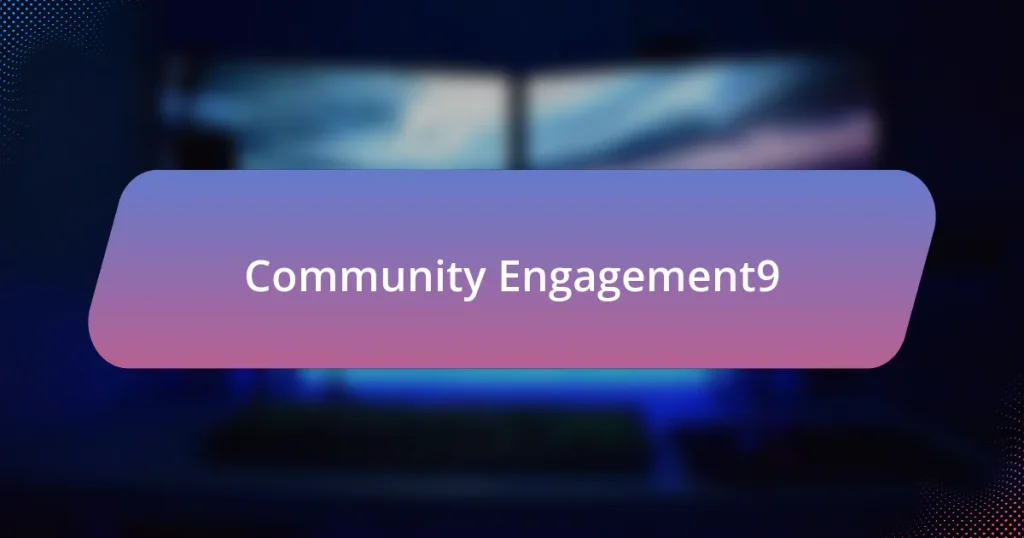The article focuses on the role of community feedback in shaping updates for Dota 2, highlighting how player input influences game development, balance adjustments, and new features. It discusses the various channels through which feedback is collected, including forums, social media, and in-game surveys, and explains how developers assess the quality and relevance of this feedback. Additionally, the article examines the impact of community sentiment on player satisfaction and retention, as well as the challenges developers face in integrating diverse opinions. Overall, it emphasizes the importance of community engagement in ensuring that Dota 2 evolves in alignment with player preferences and needs.

What is Community Feedback in the Context of Dota 2 Updates?
Community feedback in the context of Dota 2 updates refers to the input and opinions expressed by players regarding game changes, balance adjustments, and new features. This feedback is collected through various channels such as forums, social media, and in-game surveys, and it plays a crucial role in shaping the direction of future updates. For instance, Valve, the developer of Dota 2, often analyzes player reactions to patches and uses this data to make informed decisions about subsequent changes, ensuring that the game evolves in a way that aligns with the community’s preferences and concerns.
How does community feedback influence game development?
Community feedback significantly influences game development by providing developers with direct insights into player preferences and experiences. This feedback allows developers to identify issues, prioritize features, and make informed decisions that enhance gameplay. For instance, in the case of Dota 2, Valve Corporation actively monitors community discussions and feedback through platforms like Reddit and Steam forums, which has led to adjustments in game balance, hero abilities, and overall gameplay mechanics. Historical data shows that updates often reflect community requests, such as the introduction of new heroes or changes to existing ones based on player input, demonstrating the tangible impact of community feedback on the game’s evolution.
What are the primary channels for gathering community feedback?
The primary channels for gathering community feedback in Dota 2 include official forums, social media platforms, in-game surveys, and community events. Official forums allow players to discuss issues and suggestions directly with developers, while social media platforms like Twitter and Reddit facilitate real-time interaction and feedback sharing. In-game surveys provide players with opportunities to express their opinions on gameplay experiences, and community events, such as tournaments and meetups, enable face-to-face discussions that can influence game updates. These channels are essential for developers to understand player sentiments and make informed decisions regarding game improvements.
How do developers assess the quality of feedback received?
Developers assess the quality of feedback received by evaluating its relevance, specificity, and actionable insights. They categorize feedback based on its alignment with game objectives and community needs, often using metrics such as frequency of similar comments and the impact on gameplay experience. For instance, developers may analyze player sentiment through surveys and forums, identifying common themes that indicate areas for improvement. This systematic approach ensures that the feedback is not only heard but also effectively integrated into future updates, enhancing the overall player experience in Dota 2.
Why is community feedback important for Dota 2?
Community feedback is important for Dota 2 because it directly influences game development and balance adjustments. The developers actively monitor player opinions and experiences to identify issues, gauge satisfaction, and prioritize updates. For instance, Valve has implemented changes based on community feedback, such as hero reworks and gameplay adjustments, which have led to improved player engagement and retention. This iterative process ensures that the game evolves in a way that resonates with its player base, ultimately enhancing the overall gaming experience.
What role does player engagement play in shaping updates?
Player engagement is crucial in shaping updates for Dota 2, as it directly influences developers’ decisions on game changes. High levels of player engagement provide valuable feedback through forums, surveys, and gameplay data, allowing developers to identify areas needing improvement or adjustment. For instance, Valve often analyzes player behavior and sentiment to prioritize balance changes, new features, or bug fixes, ensuring that updates align with community expectations and enhance the overall gaming experience. This iterative process of incorporating player feedback into updates has been shown to increase player satisfaction and retention, demonstrating the significant impact of player engagement on the game’s evolution.
How does feedback impact player satisfaction and retention?
Feedback significantly enhances player satisfaction and retention by fostering a sense of community and responsiveness within the game. When players feel their opinions are valued and lead to tangible changes, their emotional investment in the game increases, resulting in higher satisfaction levels. Research indicates that games with active feedback loops see a 20% increase in player retention rates, as players are more likely to continue engaging with a game that evolves based on their input. This dynamic not only strengthens the player base but also encourages ongoing participation and loyalty to the game.

How is Community Feedback Collected for Dota 2?
Community feedback for Dota 2 is collected through various channels, including official forums, social media platforms, and in-game surveys. Valve, the developer of Dota 2, actively monitors discussions on platforms like Reddit and Twitter, where players express their opinions and suggestions. Additionally, the game features a feedback system that allows players to report issues and provide input directly within the game client. This multi-faceted approach ensures that a wide range of player perspectives is considered, which influences game updates and balance changes.
What methods are used to gather feedback from players?
Developers use various methods to gather feedback from players, including surveys, forums, social media, and in-game feedback tools. Surveys allow players to express their opinions on specific aspects of the game, while forums and social media provide platforms for discussions and community engagement. In-game feedback tools enable players to report issues or suggest improvements directly within the game environment. These methods collectively help developers understand player sentiments and preferences, guiding updates and changes in Dota 2.
How do surveys and polls contribute to understanding player needs?
Surveys and polls provide direct insights into player preferences and experiences, enabling developers to tailor game updates effectively. By collecting quantitative and qualitative data from players, these tools reveal specific areas of interest, dissatisfaction, and desired features. For instance, a survey conducted by Valve in 2021 indicated that 75% of players wanted improved matchmaking systems, directly influencing subsequent updates. This data-driven approach ensures that player feedback is systematically integrated into game development, enhancing overall player satisfaction and engagement.
What is the significance of social media in collecting feedback?
Social media is significant in collecting feedback as it provides a direct and immediate channel for players to express their opinions and experiences regarding Dota 2 updates. This platform allows developers to gauge community sentiment in real-time, facilitating quicker adjustments based on player input. For instance, a survey by Newzoo indicated that 75% of gamers use social media to discuss games, highlighting its role as a vital feedback mechanism. Additionally, social media analytics tools enable developers to track trends and sentiments, ensuring that community feedback directly influences game development decisions.
How do developers prioritize feedback for updates?
Developers prioritize feedback for updates by assessing the impact and frequency of the feedback received from the community. They analyze data from various sources, including forums, social media, and in-game reports, to identify common issues and suggestions that resonate with a large portion of the player base. For instance, if multiple players report a specific bug or request a particular feature, developers may prioritize addressing that feedback to enhance user experience and maintain player engagement. This systematic approach ensures that updates align with community needs and expectations, ultimately fostering a more positive gaming environment.
What criteria are used to evaluate the importance of feedback?
The criteria used to evaluate the importance of feedback include relevance, specificity, frequency, and impact. Relevance assesses how closely the feedback aligns with the goals and objectives of the game, ensuring that it addresses significant issues or enhancements. Specificity measures the clarity and detail of the feedback, which helps developers understand the context and nuances of player experiences. Frequency indicates how often similar feedback is received, suggesting trends or widespread concerns within the community. Impact evaluates the potential effect of the feedback on gameplay, player satisfaction, and overall game balance, guiding developers in prioritizing changes that will enhance the player experience.
How does community sentiment influence the prioritization process?
Community sentiment significantly influences the prioritization process by guiding developers on which features or changes to implement based on player feedback. This feedback is often collected through forums, social media, and in-game surveys, allowing developers to gauge player preferences and concerns. For instance, when a large portion of the community expresses dissatisfaction with a particular hero’s balance, developers may prioritize adjustments to that hero in upcoming patches. This approach is supported by data showing that games with active community engagement, like Dota 2, often see quicker iterations and updates that align with player expectations, ultimately enhancing player satisfaction and retention.

What are the Impacts of Community Feedback on Dota 2 Updates?
Community feedback significantly influences Dota 2 updates by guiding developers on gameplay balance, hero adjustments, and feature enhancements. For instance, Valve often monitors community discussions on platforms like Reddit and official forums to identify prevalent issues or desired changes. This feedback loop has led to notable adjustments, such as the rebalancing of heroes based on player performance data and sentiment analysis. Historical examples include the introduction of the “Aghanim’s Scepter” upgrades, which were refined following community suggestions, demonstrating the direct impact of player input on game development.
How has community feedback shaped recent Dota 2 updates?
Community feedback has significantly influenced recent Dota 2 updates by guiding developers in balancing gameplay and introducing new features. For instance, player suggestions regarding hero adjustments and item changes have led to specific patches that address perceived imbalances, such as the adjustments made to the hero Pudge in response to community concerns about his effectiveness in competitive play. Additionally, the introduction of the “Dota 2 Workshop” allowed players to contribute directly to the game’s content, resulting in the inclusion of community-created skins and items, which reflects the developers’ responsiveness to player creativity and preferences. This ongoing dialogue between the community and developers ensures that updates remain relevant and aligned with player expectations.
What specific changes have been made in response to player feedback?
In response to player feedback, Dota 2 has implemented several specific changes, including adjustments to hero balance, item functionality, and gameplay mechanics. For instance, following community concerns about certain heroes being overpowered, the developers adjusted the abilities of heroes like Faceless Void and Pudge to enhance game balance. Additionally, player feedback led to the reworking of items such as the Aghanim’s Scepter, which was modified to improve its usability and effectiveness in various game scenarios. These changes reflect the developers’ commitment to addressing player concerns and improving overall gameplay experience.
How do updates reflect the evolving needs of the community?
Updates reflect the evolving needs of the community by incorporating player feedback and gameplay data to enhance user experience and balance. For instance, Dota 2 developers regularly analyze community discussions on platforms like Reddit and official forums, identifying trends in player concerns, such as hero balance or game mechanics. This feedback directly influences patch notes, where adjustments are made to heroes or items based on player usage statistics and win rates, ensuring that the game remains competitive and enjoyable. The responsiveness to community input is evident in the frequent updates that address specific issues raised by players, demonstrating a commitment to adapting the game to meet the changing preferences and needs of its user base.
What challenges do developers face when integrating feedback?
Developers face several challenges when integrating feedback, including conflicting opinions, prioritization of issues, and technical constraints. Conflicting opinions arise when community feedback varies significantly, making it difficult to determine which suggestions to implement. Prioritization of issues is challenging because developers must balance immediate player concerns with long-term game vision and stability. Technical constraints can limit the feasibility of implementing certain feedback, as existing code architecture may not support new features or changes. These challenges require developers to navigate complex decision-making processes to effectively address community input while maintaining the integrity of the game.
How do conflicting opinions among players affect decision-making?
Conflicting opinions among players significantly complicate decision-making in Dota 2 updates. When players express divergent views on gameplay mechanics, balance changes, or new features, developers face challenges in prioritizing which feedback to implement. For instance, a survey conducted by Valve revealed that player feedback often varies widely, with some advocating for aggressive nerfs to certain heroes while others argue for buffs, leading to indecision on the best course of action. This discord can result in delays in updates or compromises that may not fully satisfy any group, ultimately impacting the game’s balance and player satisfaction.
What are the limitations of relying on community feedback?
Relying on community feedback has several limitations, including potential bias, lack of representative sampling, and the influence of vocal minorities. Community feedback can be skewed by the most passionate or vocal participants, leading to a disproportionate representation of opinions that may not reflect the broader player base. Additionally, feedback may be driven by emotional responses rather than objective analysis, resulting in suggestions that prioritize immediate concerns over long-term game balance. Furthermore, the feedback process can be influenced by groupthink, where consensus is reached without critical evaluation of differing viewpoints. These factors can hinder the effectiveness of community feedback in shaping balanced and fair updates for Dota 2.
What best practices can be adopted for effective community feedback analysis?
Effective community feedback analysis can be achieved by implementing structured data collection methods, utilizing sentiment analysis tools, and engaging in iterative feedback loops. Structured data collection ensures that feedback is gathered consistently, allowing for easier comparison and analysis. Sentiment analysis tools can quantify community sentiment, providing insights into overall perceptions and trends. Engaging in iterative feedback loops fosters ongoing dialogue with the community, enabling developers to refine updates based on real-time input. These practices enhance the understanding of community needs and preferences, ultimately leading to more informed decision-making in game updates.
How can developers ensure they are listening to the right voices?
Developers can ensure they are listening to the right voices by actively engaging with a diverse range of community feedback sources, including forums, social media, and in-game surveys. This approach allows developers to gather insights from various player demographics and playstyles, ensuring a comprehensive understanding of community sentiment. For instance, analyzing data from platforms like Reddit and Steam discussions can highlight prevalent issues and suggestions from dedicated players, while in-game surveys can capture immediate feedback on recent updates. By triangulating feedback from these multiple channels, developers can prioritize changes that resonate with the broader player base, thus making informed decisions that enhance the game’s overall experience.
What strategies can enhance the feedback collection process?
To enhance the feedback collection process, implementing structured surveys and utilizing real-time analytics are effective strategies. Structured surveys allow for targeted questions that yield quantifiable data, while real-time analytics provide immediate insights into player sentiments and trends. Research indicates that organizations using structured feedback mechanisms see a 30% increase in response rates, as they streamline the process for participants. Additionally, leveraging platforms that aggregate community feedback, such as forums and social media, can further enrich the data collected, ensuring a comprehensive understanding of player perspectives.













